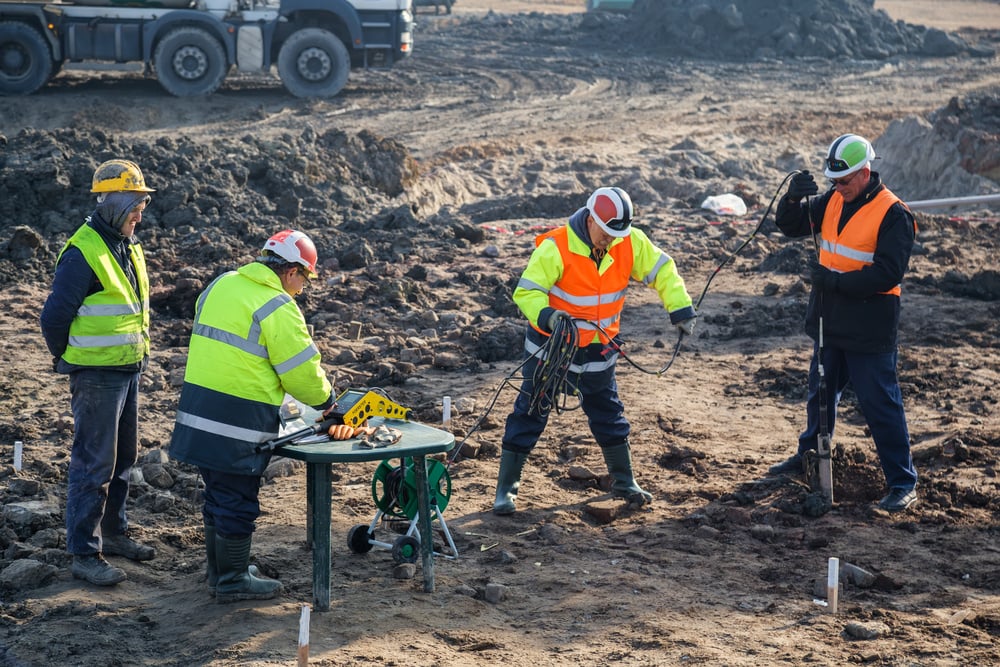The Best Guide To Geotechnical Engineering For Construction Projects
Everything about Geotechnical Engineering For Construction Projects
Table of ContentsGetting My Geotechnical Engineering For Construction Projects To WorkThe smart Trick of Geotechnical Engineering For Construction Projects That Nobody is Talking AboutThe Facts About Geotechnical Engineering For Construction Projects RevealedRumored Buzz on Geotechnical Engineering For Construction ProjectsAn Unbiased View of Geotechnical Engineering For Construction ProjectsGet This Report about Geotechnical Engineering For Construction ProjectsWhat Does Geotechnical Engineering For Construction Projects Mean?
Concepts and Practice of Ground Enhancement. Ground Enhancement Principles And Applications In Asia. Layout analysis in rock auto mechanics.Cengage Understanding, Stamford, 666 p. Atkinson, J., 2007. The auto mechanics of soils and foundations. Taylor & Francis, N.Y., 442 p. Floating Offshore Wind Wind Turbines: Reactions in a Sea state Pareto Ideal Layouts and Economic Assessment, P. Sclavounos et al., October 2007. Nicholson, D, Tse, C and Cent, C. (1999 ). The Observational Method in ground engineering principles and applications.
What Does Geotechnical Engineering For Construction Projects Mean?
Laboratory and area testing plays an important role in this procedure. By removing samples from the planet's subsurface and applying a collection of examinations, geotechnical engineers can forecast the behaviour of dirt layers and assess their viability for different construction efforts. The essence of geotechnical engineering in civil engineering can not be overemphasized, attributable to several variables: The initial action in any kind of geotechnical research study entails establishing the dirt type at the construction site.
Comprehending these attributes ensures that only appropriate dirt types are picked for the development, thus averting prospective architectural failings. The foundation acts as the bedrock of any kind of construction project. Selecting the appropriate foundation type is a choice that rests on the extensive evaluation supplied by geotechnical engineering. This makes certain the durability and stability of structures by fitting the tons they will bear.

Geotechnical website examination is an essential step in the planning and execution of any kind of construction job. It involves the collection and evaluation of information related to the physical residential or commercial properties of dirt and rock beneath a suggested building and construction site. This information is vital for the layout and building and construction of safe, stable, and sustainable structures.
See This Report about Geotechnical Engineering For Construction Projects
, additionally understood as subsurface expedition, includes a collection of activities aimed at determining the dirt, rock, and groundwater problems at a construction site. The main purposes are to identify prospective geotechnical hazards, examine the engineering properties of subsurface products, and offer suggestions for the layout and construction of foundations, keeping wall surfaces, and various other frameworks.
The desk study helps in recognizing prospective geotechnical concerns and planning the subsequent fieldwork. This entails observing the topography, drainage patterns, existing structures, vegetation, and any kind of indicators of instability or disintegration.
8 Easy Facts About Geotechnical Engineering For Construction Projects Described
Superficial test pits are excavated to straight observe and example the soil and rock. This approach is beneficial for studying the upper layers of the subsurface and determining near-surface threats. Non-invasive geophysical techniques, such as seismic refraction, ground-penetrating radar (GPR), and electric resistivity tomography (ERT), are made use of to map subsurface conditions and discover abnormalities.
Soil and rock examples collected throughout the area investigation undergo lab screening to identify their physical Recommended Reading and mechanical residential properties. Typical laboratory examinations include grain size analysis, Atterberg limitations, compaction tests, triaxial shear tests, and consolidation examinations. These examinations supply necessary information for geotechnical evaluation and style. The information collected from the desk research, site reconnaissance, area examination, and lab testing are analyzed and interpreted to establish an extensive understanding of the subsurface conditions.
The main advantage of geotechnical website investigation is guaranteeing the security and security of structures. By comprehending the subsurface conditions, designers can make foundations and other structural elements that can stand up to the lots and environmental forces they will certainly be subjected to. This decreases the danger of settlement, subsidence, and structural failure.
Top Guidelines Of Geotechnical Engineering For Construction Projects
This makes certain efficient and secure building methods. Geotechnical site investigations are commonly needed by constructing codes and policies.
This details is important for job managers, architects, and service providers in developing reasonable routines, spending plans, and contingency strategies. Geotechnical Engineering for Construction Projects. High-Rise Structure in a Coastal AreaIn a coastal city, a high-rise domestic structure was prepared on a website with thought loosened sand deposits and a high water table. An in-depth geotechnical investigation, including borehole boring, CPT, and geophysical studies, was performed
Indicators on Geotechnical Engineering For Construction Projects You Need To Know
Based upon these findings, the structure design was modified to consist of deep stack structures prolonging into secure strata, and ground renovation strategies, such as vibro-compaction, were executed to alleviate liquefaction threats. browse around this site This aggressive strategy ensured the safety and security and security of the building while preventing pricey post-construction removal. Facilities Development on a Sloping TerrainA significant framework job, involving the building and construction of a highway and bridges, was prepared on a sloping surface with steep inclines.

The Leaning Tower of Pisa (Italy), a renowned building marvel, is notorious for its unplanned tilt from considerable geotechnical problems. The read review tower's foundation was inadequately created to take care of the soft, unpredictable dirt underneath it, causing irregular settlement and its distinctive lean. Our globe is dotted with outstanding facilities projectsfrom looming high-rises to sprawling bridgesall standing testimony to the evolution of the numerous building equipment and techniques available.
Geotechnical engineering is a customized area within civil engineering that focuses on studying the actions of planet products. This branch delves deep right into the groundinvestigating exactly how the dirt, rock, and groundwater at a building site can influenceand be influenced bythe framework that we put up on and right into them. Prior to a solitary block is laid or a concrete foundation put, geotechnical engineers probe right into the earthgathering essential information about the site's dirt make-up, rock framework, and groundwater degrees.
Geotechnical Engineering For Construction Projects Can Be Fun For Anyone

is a device utilized to assess the stability and load-bearing capacity of heaps during installment, leveraging the principle of wave proliferation. It enhances construction effectiveness by supplying real-time assessments, thus guaranteeing secure and reliable pile foundations. Among the functional applications of geotechnical engineering entails making a decision and implementing the best methods for foundation construction.
Stack driving stands for more than the plain act of placing architectural aspects into the ground. On the other hand, it is a carefully coordinated process of moving a framework's tons past the less secure dirt layers closer to the surfacedown to the a lot more significant strata that exist underneath. When it comes to stack driving, consider how geotechnical designers adeptly use this method to evenly distribute the structure's weight.